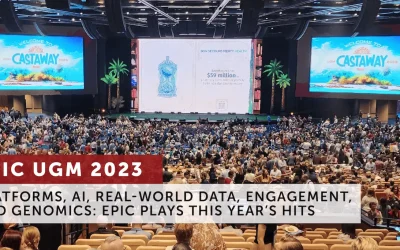
In years of attending my health care and technology industry conferences, – if we’re being honest – conferences were a waste of time. There were simply too many conferences with too many vendor and consultant attendees. COVID-19 has changed all of that. The in-person conference is, at least for the next couple of years, if not more, a thing of the past.
Enter the virtual conference. The format of the virtual conference lends itself to replicating all the least useful parts of an industry event without any of the elements that redeem them. While the content of the discussions at the World Medical Innovation Forum (WMIF) and the Becker’s Health IT, Clinical Leadership and Pharmacy Conference was some of the best I can remember, they were still seriously lacking in essential areas. Conference organizers need to look seriously at what they offer, and how they can enable the more valuable, less scripted content the healthcare industry needs in a virtual context.
Key Takeaways
- The COVID public health emergency has helped show what is and what is not valuable about these events. Practical discussions about short term problem solving, less scripted presentations, and a willingness to be candid are both more interesting and more useful.
- It is the conversations and ongoing discussion that make in-person networking at a good conference so valuable. A mix of attendees from a variety of organizations and provider settings offers an invaluable access to a breadth of perspective and expertise that is notably missing from virtual conferences.
- Representatives from small practices and community hospitals have limited travel and conference budgets, and a serious lack of free time. Even when attendance is discounted or comped, they can struggle to attend. Free, one-day virtual conferences are an ideal opportunity to bring them and their perspectives into larger discussions about the use of technology in healthcare.
- The general focus on large hospitals and health systems at conferences loses essential perspective from organizations that are not able or prepared to replicate their successes. An increased emphasis on the inclusion of small practices and community health resources is needed to keep advice and recommendations practical.
Real Value in Going Off Script
On May 11 and May 21, the WMIF and Beckers did their best to keep going in the era of COVID-19, each hosting one-day virtual events in place of their cancelled conferences. Despite sparse offerings largely (and understandably) focused on the current health emergency, they managed to be some of the most interesting, useful panels and presentations I’ve heard from a conference in years.
A willingness to be relatively impromptu, to discuss things more current and raw than the usual three-to-five-year transformation trajectory summed up into 25 minutes of PowerPoint, led to conversations that were interesting and relevant. Practical and productive topics like how to implement virtual health platforms, how to manage staff and providers scared of coming in to work, or guidelines for navigating new waivers, reimbursement and regulatory structures were a welcome change of pace from the conference norm.
Reflections on how previous disaster and contingency planning had fallen short were fascinating. The scale and timespan of the public health emergency have vastly exceeded FEMA trainings, but the emphasis on dispersed command structures and flexible organizational structures paid off for organizations that had trained in them. Especially notable was the willingness of speakers to not just present their success stories, but to speak about their failures or did not work out as planned. As one speaker noted, just reducing mistakes can be enough to make a difference, without needing to implement new technology or integrate the latest AI platform.
Attendees Make the Conference
But these virtual conferences still felt sterile. They were, after all, essentially just a series of videos. Too many traditional conferences lean on their scripted content as a value offering, with keynotes, panels, and presentations as the major focus. Virtual conferences lend themselves to that, reinforcing the worst traits of the in-person events. A good conference offers that essential thing we’ll travel and spend for; a chance to have impromptu discussions with peers or even the speakers after a presentation.
This is especially important given the immense variation in resources, culture, and preparedness that exists in healthcare. The needs and challenges in a small primary care practice are very different than a large multispecialty system, and a local community hospital uses technology and leverages IT differently than an academic medical center. Too often, the solutions and technologies presented by large, sophisticated systems and the vendors they have partnered with are not viable for these smaller practices.
It is the attendees who can and do provide that perspective, and their role in these two virtual conferences was sorely missed. After listening to a long conversation between representatives from the Cleveland Clinic and Stanford Health, what was needed was the point of view of a floor nurse at a community hospital or the medical director of a primary care practice. At a good live conference, those people can be found. At a bad conference, or currently an excellent virtual one, there is no opportunity to have that conversation.
This does not have to be the case. Breakout rooms or discussion sections could be used to give attendees the chance to talk and share their thoughts and experiences. It would not be as good as an in-person conversation, but it would be a vast improvement over the current state we are experiencing with the plethora of virtual events.




0 Comments